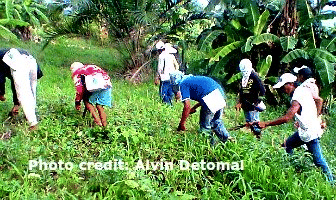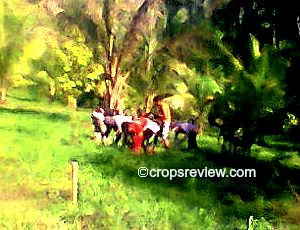Method of planting - Modern Techniques of Raising Field & Horticultural Crops, Crop Production | Crop Production Notes- Agricultural Engineering PDF Download
Various methods of planting are practiced in crop farming. These can be put under broad classifications such as direct seeding vs. transplanting, direct planting vs. indirect planting, and manual vs. mechanized planting. This page is about the first alternative methods as applied mainly to crops that can be grown from seeds.
Direct Seeding vs. Transplanting
In general, a farmer who intends to raise a crop has to choose between these two planting methods: direct seeding and transplanting. To briefly distinguish, direct seeding means planting at the crop area with the use of seeds while transplanting is planting with the use of pre-grown seedlings or plants that had been propagated from seeds. Crop area is here meant to refer to any space intended for the permanent growing of crops for the purpose of harvesting some products.
Therefore, the two methods can also be described as direct planting and indirect planting. For transplanting, it is indirect because the seeds are not immediately sown on the field. Instead, these seeds are first used to raise seedlings in pots or in any temporary place and only when they reach the right age are they outplanted. The actual field planting may be accomplished either manually or by mechanical means.
Where These Methods of Planting are More Preferred
First, let it be clarified that crop plants which are normally grown from seeds can also be grown from seedlings, theoretically at least. In fact, corn (maize) grains at milking stage can be used as raw material to produce seedlings. By tissue culture techniques, the embryo can be extracted and used as propagule. Its application for commercial grain production, however, is another matter.

Whether to choose direct seeding or transplanting for field planting depends on many factors. Among others, these include: (1) the crop species to be grown, (2) ease in planting and survival rate, (3) farmer's familiarity, (4) timeliness, (5) financial capability of the farmer, and (6) return on investment.
Consider corn. Why is it grown from seeds (grains) all throughout the world? First, because corn cannot be propagated using other plant parts. It is likewise presumed that only a very few are aware that immature corn seeds can be used to produce potted seedlings which in turn can be outplanted. The supporting technology is not even available, indicating perhaps that producing seedlings for commercial grain production is too farfetched.
Even if the technology for the production of pre-grown seedlings has been established, it may be too costly and may just cause delay. Indeed, why experiment on the use of seedlings when corn can be readily grown from seeds and has been for thousands of years? Even back in 1588 when Thomas Hariot of England came to what is now the United States of America, the native Indians were already planting corn with seeds in well spaced hills! (Hariot 1588).
It is different with rice. Both methods of planting are applicable and have, likewise, been proven effective and adaptable to farmers.
Crop Examples
Direct seeding is common in cereals such as upland rice, corn, sorghum and millets; pulses such as soybean, peanut, and mungbean; large-seeded vegetables like squash and other cucurbits including melons, root vegetables such as carrot and radish, many leafy vegetables, okra or lady's finger (Abelmoschus esculentus), and bitter gourd (Momordica charantia).
Examples of crops that are commonly transplanted are small-seeded vegetables like the solanaceous plants tomato, eggplant and peppers, ornamental crops, fruit trees, and many perennial crops including palms such as coconut and African oil palm (Elaeis guineensis).

Examples of crops where both direct seeding and transplanting methods of planting are commonly used are lowland rice, the Cruciferous (Brassica) vegetables cabbage, pechay and mustard, and lettuce.
Do you know that some seeds used in plant propagation are not entirely seeds? Click to read.
More About Direct Seeding and Transplanting
The term direct seeding, also called direct sowing, is also used to refer to the planting of seedpieces or underground vegetative planting materials directly into the soil as in potato (Solanum tuberosum). However, direct seeding may not be interpreted literally as “direct” as in corn. In rice, the seeds are pretreated to break dormancy, soaked in water, and incubated to initiate germination immediately before drilling or broadcating on puddled soil.
In contrast, transplanting, sometimes called replanting, is a method of planting that only requires the use of pre-grown plants, or seedlings, or vegetatively propagated clones for field planting. It does not distinguish as to the source of the planting material, that is, whether from seed or from vegetative parts of plants.
In addition, the term transplanting is also used to refer to the practice of replanting in which an already established plant in one location is moved elsewhere. Transplanting is also convenient with a few plants that can be transferred with a ball of soil around the roots. Heavy-duty mechanical transplanters have been invented for large trees.
roadcast Method
Hill method of direct seeding finds more application in no-till corn farming.
Broadcasting or sabog tanim, also called scatter planting, is a method of planting by which seeds (or grains) are scattered over a well prepared soil. There are no plant-to-plant spacing and arrangement. As a result, there are plants which may grow singly while others may occur in pair or in bunches of several plants.
This planting method is common in crops with small seeds that are capable of germination and sustained growth without soil cover. Examples are rice , millets, mungbean, cowpea and forage crops. However, there are no exact limitations. In addition to small seeds like those of forage crops, relatively large seeds including those of trees can be released from a plane or helicopter. Such a broadcasting technique is specially called aerial seeding.
With hand broadcasting, a volume of seeds is held by one hand and thrown with a wide swath. Skill is important to ensure even distribution per unit ground area based on the desired seeding rate.
In lowland rice, the seeds are broadcasted on puddled soil or over water and allowed to germinate without covering. The broadcast method of direct seeding is also common with mungbean and cowpea grown as residual crop after rice or as green manure.
Contact with the soil will improve seed germination and seedling establishment. In a pastureland, a heavy herd of animals may be released right after broadcasting of pasture crop seeds. As they move around, their hooves will press the seeds downward.
Hill Method
Hill planting is a planting method by which plants are arranged in equidistant rows and uniform hill-to-hill distances within the row. It is also called checkrow planting because on top view the hills appear as arranged uniformly at the intersections of squares of an imaginary chekerboard.
A “hill” is that specific spot on the ground where a plant or a group of plants is grown. Mounded bases of plants are likened to miniature hills.
Applied in direct seeding, this planting method consists of dropping seeds in holes made by a dibbler (or dibble) or any tool for digging small holes, or in furrows. But with mechanized farming, a combine furrower-planter (more oftenly also with a fertilizer applicator) is commonly used. Where a dibbler (or dibble, example a pointed piece of wood or a stick) is used to bore holes on the ground, hill planting is otherwise called dibbling.
There's a common practice in manual planting of corn immediately following the making of furrows:
The farmer walks forward from end to end of a freshly made furrow, dropping seeds towards the bottom of the depression. He does not carry a measuring tool, he just estimates distances on the ground with impressive accuracy borne of long experience.
To cover the seeds, he merely sweeps the ridge at either side of the furrow by the inner side of one foot to push some soil over the seed. In a continuous flow of movement, that same foot rests on top of the hill. As he lifts his rear foot and steps forward, his weight becomes concentrated on that foot over the hill and presses the soil covering the seed. Each forward step means one seed planted, properly covered.
Drill Method
The drill method of planting is another technique of direct seeding by which seeds are released continuously in a row while moving forward at uniform speed. The release of seeds is analogous to pouring water from a bottle with a small opening until water is completely exhausted. The bottle is refilled, and the process is repeated again and again.
Manual drilling applies to small seeds like rice, sorghum, millet, and mungbean and is usually done by hand alone. It can also be accomplished by placing small, roundish seeds in a bottle with a hole on the cover. The seeds are simply released by tilting and slightly shaking the bottle so that the seeds drop one after the other or in a cascade through the hole and towards the ground.
The seeds are drilled with or without furrows. In rice, drilling in puddled soil in linear direction is a modification of seed broadcasting in which plants are dispersed without plant-to-plant spacing. But in rainfed sorghum, mungbean, and other grain legumes, it is a common practice to drill the seeds at the bottom of well spaced furrows. The seeds are immediately covered with soil by raking or by foot and usually slightly pressed.
FAQs on Method of planting - Modern Techniques of Raising Field & Horticultural Crops, Crop Production - Crop Production Notes- Agricultural Engineering
| 1. What are some modern techniques used for raising field and horticultural crops? |  |
| 2. How does precision farming contribute to crop production? |  |
| 3. What is hydroponics and how is it used in crop production? |  |
| 4. What is vertical farming and how does it contribute to crop production? |  |
| 5. How does the use of biotechnology impact crop production? |  |
















